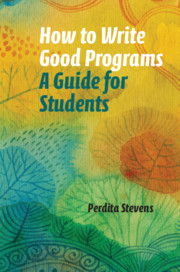12 results
Modular oversight methodology: a framework to aid ethical alignment of algorithmic creations
-
- Journal:
- Design Science / Volume 10 / 2024
- Published online by Cambridge University Press:
- 18 November 2024, e32
-
- Article
-
- You have access
- Open access
- HTML
- Export citation
Chapter 19 - Reproducible and reliable code
- from Interlude — Good practices for scientific computing
-
- Book:
- Working with Network Data
- Published online:
- 06 June 2024
- Print publication:
- 13 June 2024, pp 293-300
-
- Chapter
- Export citation
From a Monolithic PLM Landscape to a Federated Domain and Data Mesh
-
- Journal:
- Proceedings of the Design Society / Volume 2 / May 2022
- Published online by Cambridge University Press:
- 26 May 2022, pp. 713-722
-
- Article
-
- You have access
- Open access
- Export citation
15 - How to Go Beyond This Book
-
- Book:
- How to Write Good Programs
- Published online:
- 10 July 2020
- Print publication:
- 23 July 2020, pp 194-199
-
- Chapter
- Export citation
1 - Introduction
-
- Book:
- How to Write Good Programs
- Published online:
- 10 July 2020
- Print publication:
- 23 July 2020, pp 1-8
-
- Chapter
- Export citation

How to Write Good Programs
- A Guide for Students
-
- Published online:
- 10 July 2020
- Print publication:
- 23 July 2020
Developing Computer Simulation Models for Estimating Risks of pesticide use: Research vs. user Needs
-
- Journal:
- Weed Technology / Volume 6 / Issue 3 / September 1992
- Published online by Cambridge University Press:
- 12 June 2017, pp. 677-682
-
- Article
- Export citation
A Generalized Model of PAC Learning and itsApplicability
-
- Journal:
- RAIRO - Theoretical Informatics and Applications / Volume 48 / Issue 2 / April 2014
- Published online by Cambridge University Press:
- 09 April 2014, pp. 209-245
- Print publication:
- April 2014
-
- Article
- Export citation
Design and implementation of a tracer driver: Easy and efficientdynamic analyses of constraint logic programs1
-
- Journal:
- Theory and Practice of Logic Programming / Volume 8 / Issue 5-6 / November 2008
- Published online by Cambridge University Press:
- 01 November 2008, pp. 581-609
-
- Article
- Export citation
Improving Prolog programs: Refactoring for Prolog
-
- Journal:
- Theory and Practice of Logic Programming / Volume 8 / Issue 2 / March 2008
- Published online by Cambridge University Press:
- 01 March 2008, pp. 201-215
-
- Article
- Export citation

